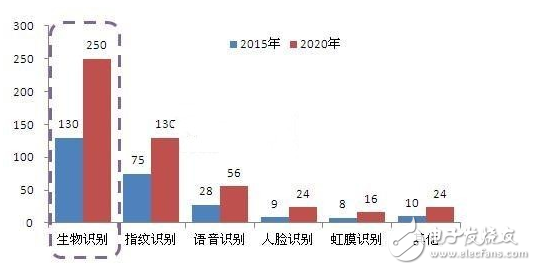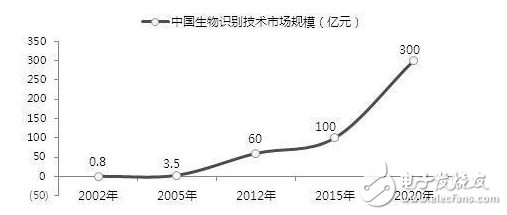Recently, at the International Terminal Equipment Exhibition, the International Aeronautical Telecommunications Group launched a technology called Smart Path to simplify the airport passenger boarding process. It is reported that with this technology, passengers only need to accept the face recognition test at the "contact point", they can enter and leave the airport and board the plane. Once verified, passengers do not need to show their boarding pass, passport or travel documents. The International Aeronautics and Telecommunications Group said that it has cooperated with many airlines and airports around the world to integrate Smart Path technology into passenger travel. It is expected that by 2020, face recognition technology will be widely used in airports around the world. As face recognition will call the airport "standard", the global biometrics industry will usher in a turning point in development, and the prospects are promising. The tens of billions of dollars market in North America, the largest Asia Pacific region Biometric identification refers to the technology of personal identification using the inherent physiological characteristics of the human body through computer and optical, acoustic, biosensor and biostatistical principles, mainly fingerprint recognition, speech recognition, face recognition. , iris recognition and other technologies. Compared with the traditional method of password verification, biometric technology is based on the characteristics of human biometrics, such as easy measurement, exclusivity and lifelong change, so it has the advantages of quick test and more accurate results. More adapt to the needs of the Internet era, users of information security and information processing and feedback. In the current global biometrics market, North America has the highest share of 33.5%; followed by Asia Pacific with 23.8%; then Europe, Middle East and India, Central and South America, and Africa, with market share of 16.5% and 11.0%. 9.1% and 6.1%. The United States is the world's leading biometrics market and currently stands at $1 billion. After the “911†incident, the United States established “US Visitor and Immigrant Identity Display Technology†system at 115 airports and 14 major ports, using fingerprint recognition, face recognition and iris recognition technologies to verify visitor and immigration information; A citizen who is a visa-free country must go to the United States and must hold a biometric passport. In 2009, the global biometric identification market was 3.422 billion US dollars. In 2013, the biometric identification market was close to 9.8 billion US dollars. In 2014, the biometric identification scale exceeded 10 billion US dollars. It is expected that the biometric identification market will rise to 13 billion US dollars in 2015 to 2020. The global biometrics market will exceed $25 billion in the year. The fingerprint identification market will have a scale of 13 billion US dollars, voice recognition will be 5.6 billion US dollars, face recognition will be 2.4 billion US dollars, iris recognition will be 1.6 billion US dollars, and other organisms will be 2.4 billion US dollars by technology. 2015-2020 global biometrics technology industry segment size forecast (unit: billion US dollars) Source: Prospective Industry Research Institute Domestic biometric identification fingerprint recognition popular face recognition rise China's biometric identification products include attendance equipment and systems, physical access control products, electronic lock products, and identity authentication (ie, logic access control, and many applications in the financial industry, e-commerce, e-government, military, wireless network services, etc.) And other products. Compared with major projects in the government and public service sectors, most of the domestic biometrics market is more than 90% of the small-scale commercial sector application, and there is huge room for development in the future. The domestic biometrics market is relatively simple, and the fingerprint recognition technology is too concentrated. According to the data, the market share of fingerprint identification technology products is almost the sum of other biometric technologies, that is, about 50%. Fingerprint recognition has the lowest threshold among many biometric technologies, so it has been developed first. At present, fingerprint recognition can be seen in many fields such as locks, attendance, access control, computers, banks and safes, and smart phones. Among them, under the demonstration effect of Apple mobile phones, in recent years, mobile phone installation fingerprint recognition devices have become standard, which further extends the prosperity of fingerprint recognition technology. As the demand for mobile payment market continues to rise, the cost of fingerprint recognition devices continues to decline. It is expected that this technology will also have the possibility of explosive development. However, as a contact recognition technology, fingerprint collection heads are often easily damaged and need to be replaced regularly; about 5% of people have shallow fingerprints and are difficult to collect; plus fingerprint recognition has higher requirements for position, so it tends to be higher. The anti-true rate, the above factors limit the future development of fingerprint recognition. This brings development space for face recognition and iris recognition technology. Compared with fingerprint recognition technology, face recognition has higher precision and is a non-contact recognition technology, which is more convenient and quicker to operate. In terms of promotion, the current common camera can be used as a sensor. Face recognition mainly relies on face recognition software and algorithms. The common camera can be used as a sensor for collecting face information. The cost is relatively low and the customer is more acceptable. Based on the above characteristics, face recognition will replace fingerprint recognition in the next stage of the biometrics industry to usher in rapid development. At present, China's face recognition technology has been used in banking institutions, Internet financial platforms and so on. It is expected that the face recognition market will explode rapidly. By 2015, the market size of China's face recognition industry can reach 7.5 billion yuan, and the potential market size in the future will exceed 100 billion. Iris recognition is the most accurate technology in biometric identification technology. It has the characteristics of low false positive rate, difficult to forge, difficult to copy, and not easy to damage biological features. In theory, it will be more accurate and reliable than fingerprint recognition and face recognition. Based on the above characteristics, future applications in security, defense, e-commerce and other fields will inevitably focus on iris recognition technology. However, because the application is not yet mature, this technology is currently considered "black technology." The three major trends in the biometrics industry in the market According to the “2016-2021 China Biometrics Industry Market Research and Investment Forecast Analysis Report†provided by Forward Industry Research Institute, the average growth rate of the domestic biometric market will remain above 60% from 2010 to 2014. The scale of the biometric market in 2014 For more than 8 billion yuan, it is estimated that by 2015 China's biometric market will exceed 10 billion yuan. In 2020, the biometric market will exceed 30 billion yuan. The government attaches importance to the downstream application and technology improvement to promote the rapid development of the biometrics market. China's biometric technology industry market size and forecast (unit: 100 million yuan) Source: Prospective Industry Research Institute Combined with the development track of biometric industry in Western countries, Forward-looking Industrial Research Institute believes that the domestic biometric identification industry will have the following development trends: First, the industrial concentration will continue to increase. From 2002 to now, the foreign biometrics industry has been eliminated through competition and a large number of M&A and restructuring, the number of biometric identification companies has dropped to more than 100, and there are even less than 15 important enterprises on the scale. The survival of the fittest in the future will appear in China; Second, the development of biometrics is balanced. The unique situation of fingerprint recognition technology will be broken. In the future, various technologies such as speech recognition, face recognition and iris recognition can be released in a row and develop together; Finally, multi-technology integration has developed into the mainstream. As information security issues become more prominent, market demand is increasingly strong, technology integration and integration (using two or more biometric technologies, such as fingerprint and face recognition; fingerprints, face plus iris recognition, etc.) to further ensure information security becomes Development trend. PWM Charge Controller, Inverter Solar Charge Controller, Green Energy Controller Bosin Power Limited , https://www.bosinsolar.com

